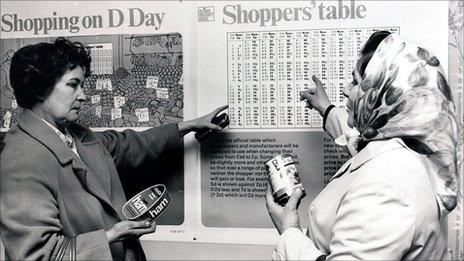How Britain converted to decimal currency
- Published
- comments

Shoppers had to learn how to use decimalised currency from 15 February 1971
Do you remember the tanner, shilling, florin and half crown?
If you do, you must be at least in your 40s, because it was back in February 1971, 40 years ago, that Britain "went decimal" and hundreds of years of everyday currency was turned into history overnight.
On 14 February that year, there were 12 pennies to the shilling and 20 shillings to the pound. The following day all that was history and the pound was made up of 100 new pence.
Decimalisation - having a currency based on simple multiples of 10 and 100 - had been a long time coming to Britain.
France and the United States had gone decimal in the 1790s. Britain first thought about doing the same in the 1820s but the idea did not gather momentum.
Prior to 1971, the closest Britain came to decimalisation was in 1849 with the introduction of the florin - a coin worth two shillings (24 old pence or 10 new pence) which was one-tenth of a pound.
During the 1960s a number of Commonwealth countries had gone decimal - Australia, New Zealand and South Africa.
"There was a sense in which there was a momentum behind this," said Dr Kevin Clancy, head of historical services at the Royal Mint. "It would have been a huge disruption, which was one of the reasons governments shied away from it."
"The old money in fact linked right the way back to ancient times," said Catherine Eagleton, curator of modern money at the British Museum.
"So it's the pound of silver divided into 240 pence. It was the historic way the Romans used their money and divided up the [librum, solidus and] denarius which was where the d in L.s.d. (or £sd) for pounds, shillings and pence comes from."
Quick decision
But remarkably it took the government only seconds to decide to get rid of the currency that had served Britain for thousands of years.
It happened one day when the then Chancellor of the Exchequer Jim Callaghan popped next door to see Prime Minister Harold Wilson.
The economist Peter Jay, who was also Mr Callaghan's son-in-law, recalled: "They talked for about 20 seconds and Wilson said 'well why not' and that is how the decision was made... in a few seconds a century and half of argument about decimalisation came to an end."
The decision was announced to Parliament in 1966.
In reality, the change-over between currencies was a gradual process. The Decimal Currency Board (DCB) was created to manage the transition.
Some three years before "D-Day" or Decimal Day, new 5p and 10p coins were introduced. They were of the same size and value as the existing one and two shilling coins. Then in 1969, a 50p coin was introduced to replace the 10-shilling note. The 50p coin was referred to as a 10-shilling coin at the time.
On Monday 15 February 1971, the process was completed when the 0.5p, 1p and 2p coins were introduced.
The banks were closed for four days from the previous Thursday to prepare for the change-over.
Save the sixpence
One old coin that survived longer than expected was the sixpence. Worth 2.5p, it remained in circulation until 1980, after a public campaign to keep it.
Dick Taverne, who was chief secretary to the Treasury a year before decimalisation said: "There was a passionate public campaign 'save our sixpence'.
"People were very fond of the coin. They said it was part of our heritage. It was thought a terrible thing to get rid of the sixpence.
"I remember in the course of the debate, one of the Labour members screaming 'But what about the housewife, she is going to miss the sixpence, she is going to be exploited - how dreadful the decision to abolish the sixpence'. It was a very emotive issue."
Forty years on, those old coins are a distant memory for those in their 40s and beyond, and a puzzlement for those too young to have known them.
But pre-decimal pennies are still in use in one part of London where they have a vital role.
They are used to adjust the timing of the pendulum of the clock in the Clock Tower of the Palace of Westminster, commonly known as Big Ben.
Archive on 4 Decimal Day - What's that in old money can be heard on Radio 4 at 8pm on Saturday 5 February and after on BBC iPlayer.